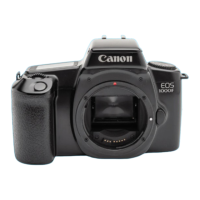
Do you have a question about the Canon EOS 1000 F and is the answer not in the manual?
| Camera Type | 35mm SLR |
|---|---|
| Lens Mount | Canon EF |
| Exposure Control | Program AE, Shutter-priority AE, Aperture-priority AE, Manual |
| Flash Sync | 1/90 sec |
| Shutter Type | Electronically controlled focal-plane shutter |
| ISO Range | 25 |
| Metering | TTL |
| Flash | Built-in flash |
| Power Source | lithium batteries |
| Dimensions | 148 mm |
| Weight | (body only) |
| Autofocus | TTL-CT-SIR (Canon TTL Cross-Type Silicon Integrated Circuit) |
Critical warnings and suggestions for optimal performance and safety.
Instructions for inserting and verifying the camera's battery status.
Step-by-step guide for mounting and dismounting camera lenses correctly.
Techniques for stable camera handling to prevent image blur from movement.
Guidance on using the autofocus system to achieve sharp subject focus.
Methods for manual focusing on subjects challenging for autofocus.
Procedures for properly loading film into the camera.
Steps for initial setup and basic shooting using the automatic Green Zone mode.
Technique for locking focus on a subject and recomposing the shot.
Explanation of automatic film rewinding and how to manually rewind the film.
Overview of automatic modes for portraits, landscapes, close-ups, and sports.
Introduction to advanced shooting modes for greater creative control and flexibility.
How to set shutter speed to control motion blur and freezing action.
How to set aperture to control depth of field for subject isolation.
Complete manual control over shutter speed and aperture for precise exposure.
Mode to ensure focus on both near and far subjects simultaneously.
Using the self-timer for 10-second delays, allowing inclusion of the photographer.
Guidelines for using the built-in flash and understanding flash distance ranges.
Metering technique focusing on a small central area for precise exposure.
Adjusting exposure by +/- 2 stops for intentional over or underexposure.
Technique for overlaying up to nine images on a single frame.
Using the bulb setting for exposures exceeding 30 seconds for night scenes.
Manually setting ISO values for non-DX coded films or custom tests.
A table comparing different autofocus and film wind modes' functionalities.
Information on the estimated number of shots per battery based on conditions.
Charts illustrating shutter speed and aperture combinations in program modes.
Visual representation of how program shift alters shutter speed/aperture settings.
Details on external flash units that offer higher power and advanced features.
Accessories for improved camera grip and viewfinder correction for eyeglass wearers.
Guidance on using lens hoods and filters to enhance image quality and effects.
Instructions for cleaning critical camera parts to maintain performance.
Notes on LCD panel behavior and essential battery checks and usage tips.
Instructions on how to properly thread and attach the camera's neckstrap.
Overview of the camera's type, main components, and physical characteristics.
Technical details of the camera's autofocus control, modes, and range.
Information on metering patterns, range, and available shooting modes.
Details on film loading, speed setting, and automatic winding mechanisms.
Specifications for compatible lenses and information on the integrated flash unit.